The Digestive System
1/253
There's no tags or description
Looks like no tags are added yet.
Name | Mastery | Learn | Test | Matching | Spaced |
|---|
No study sessions yet.
254 Terms
What is the primary function of the digestive system?
To process food, extract nutrients, and eliminate residue.
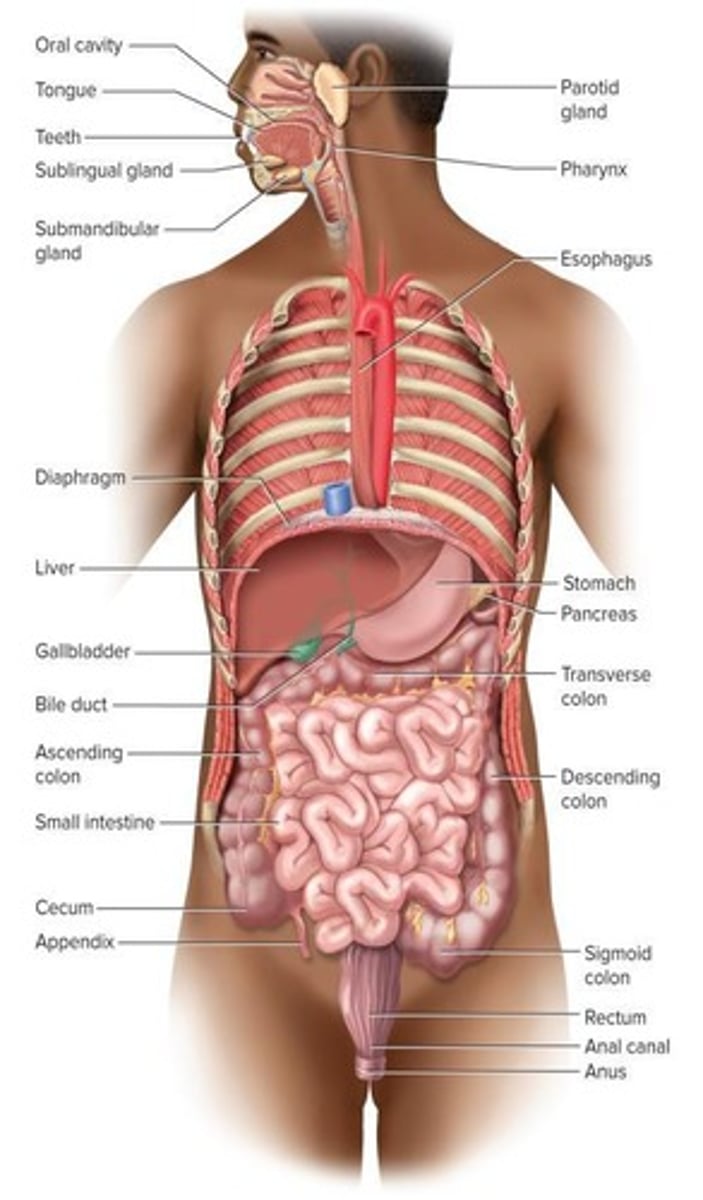
What are the five stages of digestion?
1. Ingestion: selective intake of food.
2. Digestion: mechanical and chemical breakdown of food.
3. Absorption: uptake of nutrient molecules into epithelial cells and then into blood and lymph.
4. Compaction: absorbing water and consolidating indigestible residue into feces.
5. Defecation: elimination of feces.
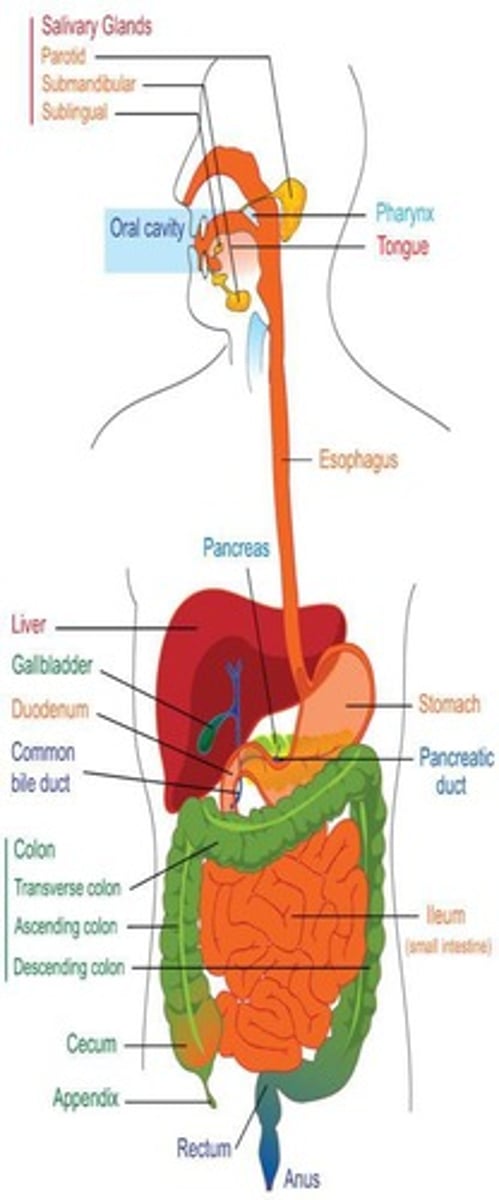
What is mechanical digestion?
The physical breakdown of food into smaller particles through actions like cutting, grinding, and churning.
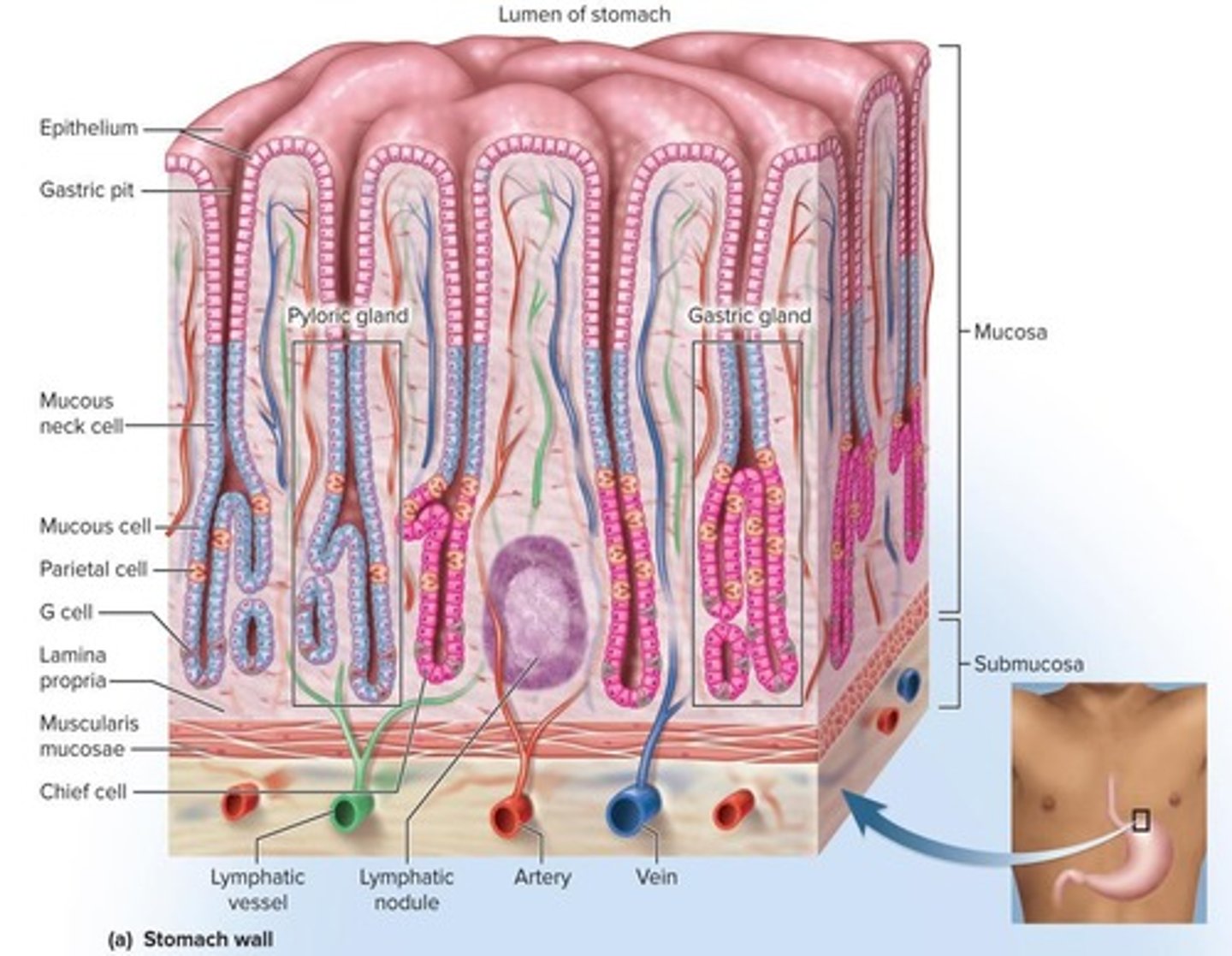
What is chemical digestion?
A series of hydrolysis reactions that break dietary macromolecules into their monomers, carried out by digestive enzymes.
What are the products of chemical digestion for polysaccharides, proteins, fats, and nucleic acids?
Polysaccharides into monosaccharides, proteins into amino acids, fats into monoglycerides and fatty acids, nucleic acids into nucleotides.
What nutrients can be directly absorbed without digestion?
Vitamins, amino acids, minerals, cholesterol, and water.
What are the two subdivisions of the digestive system?
The digestive tract (alimentary canal) and accessory organs.
What is the length of the digestive tract?
Approximately 30 feet long.
List the primary organs of the digestive tract (alimentary canal).
Mouth, pharynx, esophagus, stomach, small intestine, large intestine, rectum, anus
What is the gastrointestinal (GI) tract?
The stomach and intestines.
What are the accessory organs of the digestive system?
Teeth, tongue, salivary glands, liver, gallbladder, and pancreas.
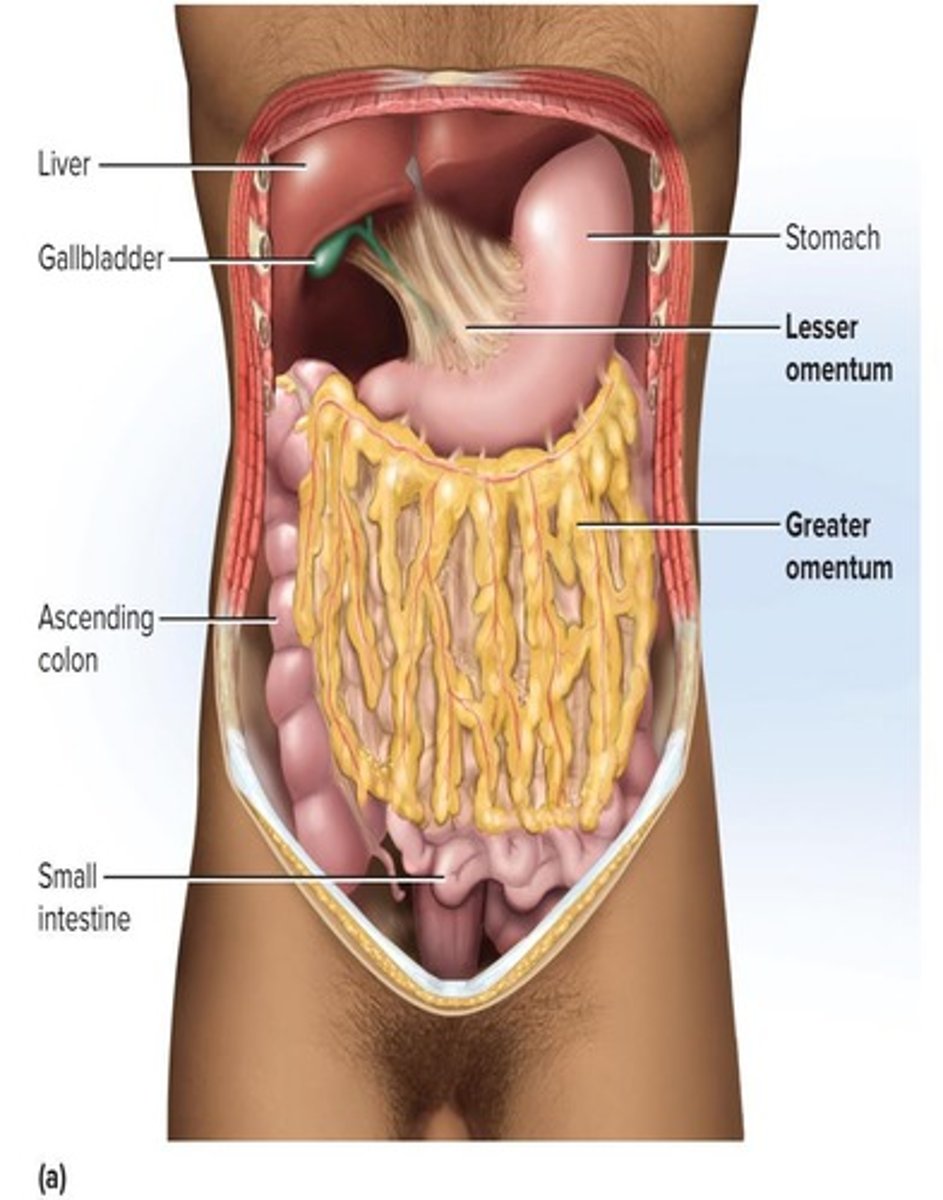
What are the four layers of the digestive tract wall? (deep to superficial)
1. Mucosa 2. Submucosa 3. Muscularis externa 4. Serosa.
What is the mucosa?
The innermost layer of the digestive tract wall, consisting of epithelium, lamina propria, and muscularis mucosae.
What type of epithelium is found in the mucosa of most of the digestive tract?
Simple columnar epithelium.
What is the function of the muscularis mucosa in the mucosa layer?
It tenses the mucosa, creating grooves and ridges that enhance surface area and contact with food.
What is the muscularis externa?
smooth muscle superficial to the lamina propria
What does the submucosa contain?
Areolar connective tissue:
Blood vessels, lymphatic vessels, a nerve plexus, and mucus-secreting glands.
What is the role of the muscularis externa?
It consists of two layers of muscle that propel food and residue through the tract.
What are the two layers of the muscularis externa?
inner circular layer and outer longitudinal layer
What is the function of the inner circular layer of the muscularis externa?
It can thicken to form valves (sphincters) that regulate the passage of material through the tract.
What is the serosa?
The outermost layer of the digestive tract wall, consisting of areolar tissue and mesothelium.
What is gastroenterology?
The study of the digestive tract and the diagnosis and treatment of its disorders.
Why is the digestive tract considered external to the body until absorption?
Most material in it has not entered the body tissues and is considered external until absorbed by the epithelial cells.
What enhances the surface area of the mucosa?
The grooves and ridges created by the muscularis mucosa.
What is the lamina propria?
areolar connective tissue that underlies all mucous membranes
What is the role of mucosa-associated lymphatic tissue (MALT) in the digestive system?
It contains an abundance of lymphocytes and lymphatic nodules that play a role in immune response.
What is the serosa composed of?
A thin layer of areolar tissue topped by simple squamous mesothelium.
Where does the serosa begin and end in the digestive tract?
Begins in the lower 3 to 4 cm of the esophagus and ends just before the rectum.
What other name is the serosa called?
Visceral peritoneum
What is the adventitia in the digestive system?
A fibrous connective tissue layer that binds and blends the pharynx, most of the esophagus, and the rectum into adjacent connective tissue of other organs.
What is the enteric nervous system?
A nervous network in the esophagus, stomach, and intestines that regulates digestive tract motility, secretion, and blood flow.
How many neurons are estimated to be in the enteric nervous system?
Over 100 million neurons.
Can the enteric nervous system function independently of the central nervous system?
Yes, but the CNS usually exerts influence on its action.
What are the two main components of the enteric nervous system?
The submucosal plexus and the myenteric plexus.
What does the submucosal plexus control?
Glandular secretions of the mucosa.
What is peristalsis?
the involuntary constriction and relaxation of the muscles of the intestine or another canal, creating wavelike movements that push the contents of the canal forward.
What does the myenteric plexus control?
Peristalsis and other contractions of the muscularis externa.
What are the other two names for the visceral peritoneum?
Serosa and mesenteries
What are mesenteries in the context of the peritoneum?
Connective tissue sheets that suspend the stomach and intestines from the abdominal wall.
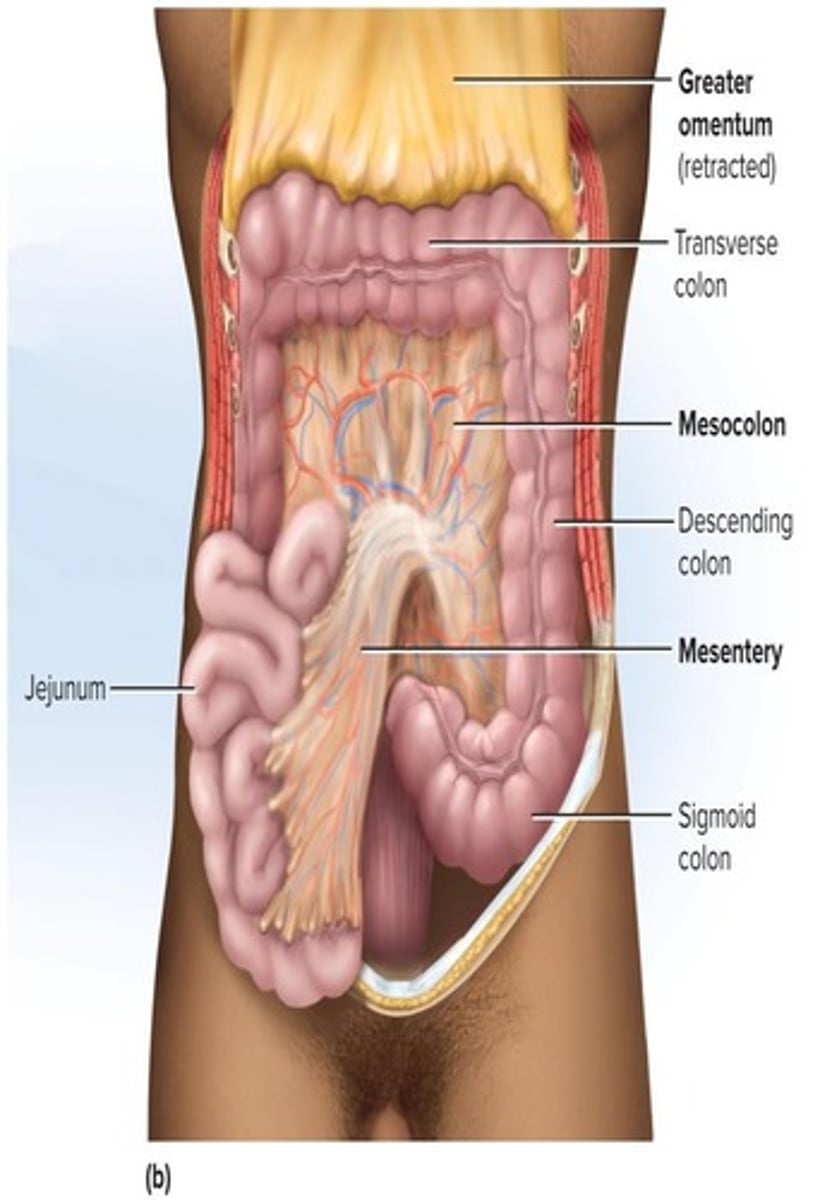
What is the function of mesenteries?
They allow the stomach and intestines to undergo contractions with freedom of movement, hold abdominal viscera in proper relationship, prevent twisting and tangling, and provide passage for blood vessels and nerves.
What is the parietal peritoneum?
A serous membrane that lines the wall of the abdominal cavity.
What is the lesser omentum?
A ventral mesentery that extends from the lesser curvature of the stomach to the liver.
- Superior to the greater omentum
What is the greater omentum?
A structure that hangs from the greater curvature of the stomach and covers the small intestine like an apron.
What is the function of the greater omentum?
It serves as part of the body's first line of defense against toxins and infections.
What is the mesocolon?
An extension of the mesentery that anchors the colon to the abdominal wall.
What does it mean for an organ to be intraperitoneal?
It is enclosed by mesentery on both sides and considered within the peritoneal cavity.
Which organs are considered intraperitoneal?
The stomach, liver, and parts of the small and large intestine.
What does it mean for an organ to be retroperitoneal?
It lies against the posterior body wall and is covered by peritoneum on its anterior side only.
Which organs are considered retroperitoneal?
The duodenum, pancreas, and parts of the large intestine.
What are the two types of neural control in the regulation of the digestive tract?
Short (myenteric) reflexes and long (vagovagal) reflexes.
What are hormones in the context of digestive regulation?
Chemical messengers secreted into the bloodstream that stimulate distant parts of the digestive tract.
What are paracrine secretions?
Chemical messengers that diffuse through tissue fluids to stimulate nearby target cells.
- Ex: Gastrin and secretin
What are the primary functions of the mouth in digestion?
Ingestion, taste and sensory responses, chewing and chemical digestion, swallowing, speech, and respiration.
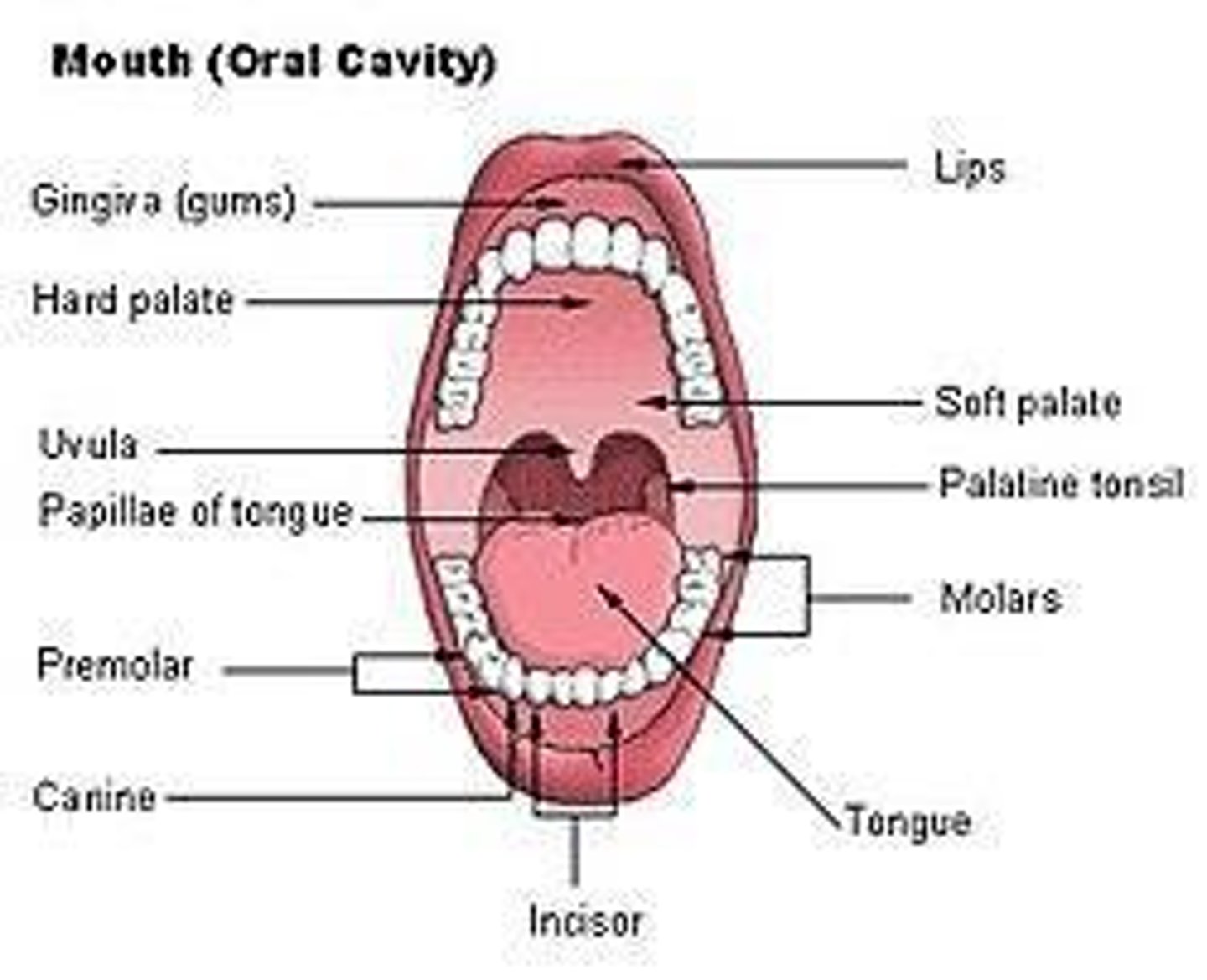
What type of epithelium lines the mouth?
Stratified squamous epithelium, keratinized in areas subject to abrasion and nonkeratinized in other areas.
What are the three areas of the lips?
Cutaneous area, red area, and the area where the lips meet.
What is the labial mucosa?
The inner surface of the lips facing the gums and teeth.
What are the primary functions of the tongue?
Manipulates food between teeth and senses taste and texture of food.
What type of epithelium covers the surface of the tongue?
Nonkeratinized stratified squamous epithelium.
What are lingual papillae?
Bumps and projections on the tongue that are the sites of most taste buds.
What are the two main parts of the tongue?
The body (anterior two-thirds) and the root (posterior one-third).
What is the function of the lingual frenulum?
It is a median fold that attaches the body of the tongue to the floor of the mouth.
What are intrinsic muscles of the tongue responsible for?
Producing subtle tongue movements of speech.
What are extrinsic muscles of the tongue responsible for?
Producing stronger movements of food manipulation.
What is the function of the palate?
Separates the oral cavity from the nasal cavity, allowing breathing while chewing.
What is the difference between the hard and soft palate?
The hard palate is the anterior bony portion, while the soft palate is the posterior spongy portion composed of muscle and glandular tissue.
What is the uvula?
A conical medial projection visible at the rear of the mouth that helps retain food until swallowing.
What is the primary function of teeth?
To masticate (chew) food into smaller pieces, making it easier to swallow and exposing more surface area for digestion.
How many adult teeth do humans have?
32 adult teeth, with 16 in the mandible and 16 in the maxilla.
What types of teeth are present in the human mouth?
2 incisors, 1 canine, 2 premolars, and 3 molars.
What is an alveolus in dental anatomy?
The tooth socket in bone where a tooth is anchored.
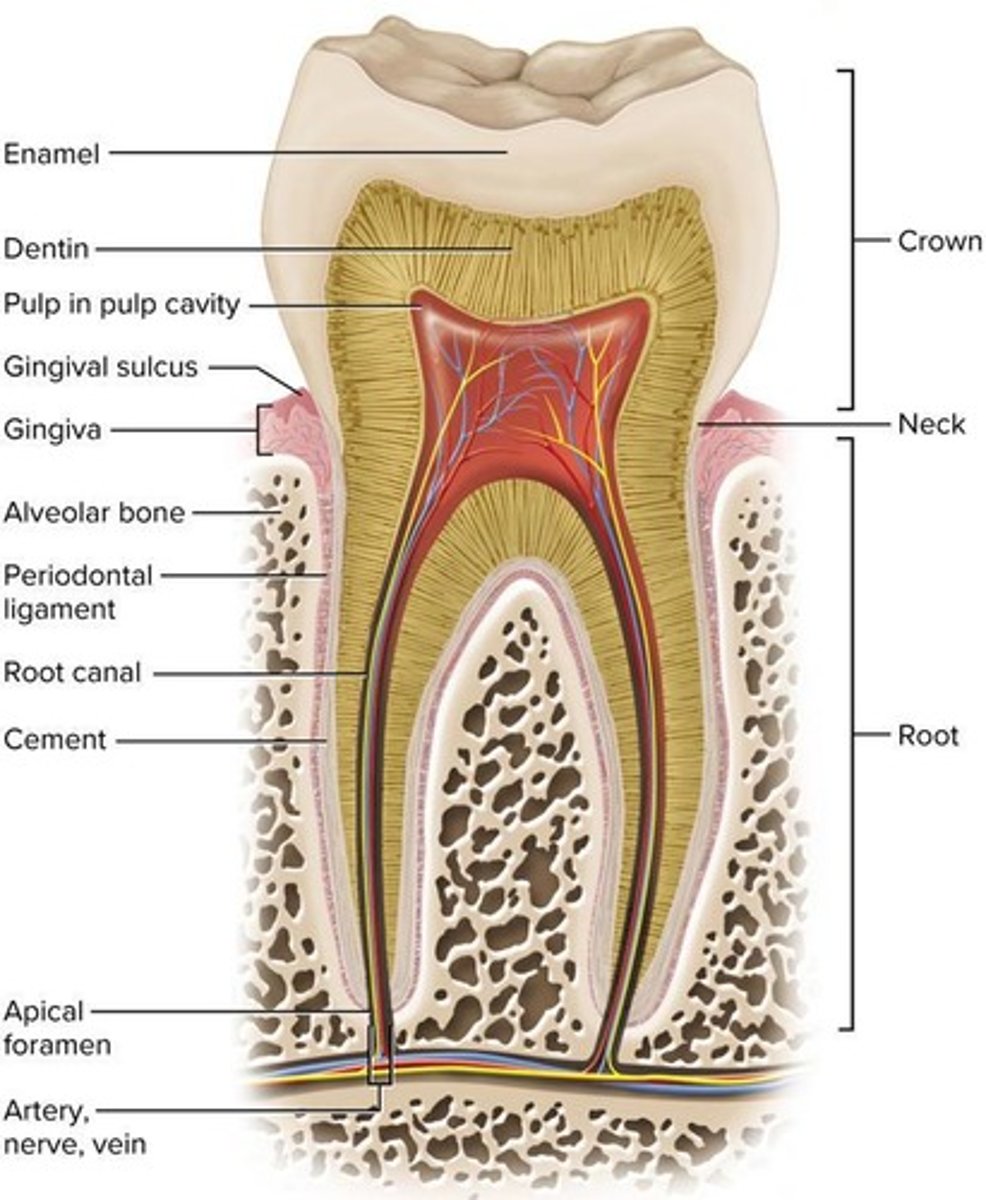
What is the periodontal ligament?
A modified periosteum that anchors the tooth in the alveolus and allows slight movement during chewing.
What are the regions of a tooth?
Crown (above the gum), root (below the gum), neck (where crown, root, and gum meet), and gingival sulcus (space between tooth and gum).
What is dentin?
A hard yellowish tissue that makes up most of the tooth.
What is enamel?
A noncellular secretion that covers the crown and neck of the tooth and cannot regenerate.
What is the root canal?
The space in a root leading to the pulp cavity in the crown, containing nerves and blood vessels.
What are deciduous teeth?
Also known as milk teeth or baby teeth, there are 20 of them that develop beneath the gums and erupt in a predictable order.
What are the functions of saliva?
Moistens the mouth, begins starch and fat digestion, cleanses teeth, inhibits bacterial growth, dissolves molecules for taste, and binds food into a bolus.
What are the main components of saliva?
97.0% to 99.5% water, salivary amylase, lingual lipase, mucus, lysozyme, immunoglobulin A (IgA), and electrolytes.
What are intrinsic salivary glands?
Small glands dispersed amid other oral tissues, including lingual, labial, palatine, and buccal glands, that secrete saliva at a constant rate.
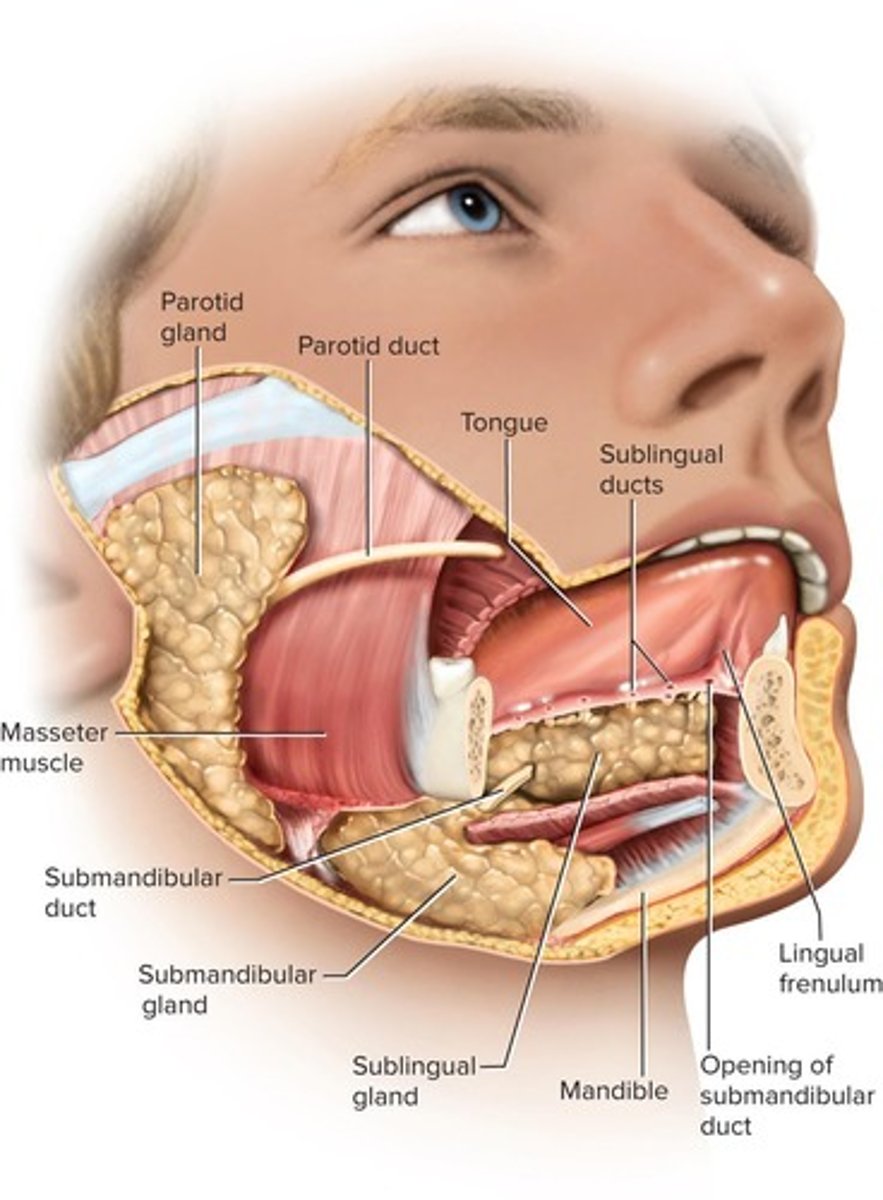
What are the three pairs of extrinsic salivary glands?
Parotid, submandibular, and sublingual glands.
Where is the parotid gland located?
Beneath the skin anterior to the earlobe.
What viral infection causes inflammation and swelling of the parotid gland?
Mumps.
Where is the submandibular gland located?
Halfway along the body of the mandible, with its duct emptying at the side of the lingual frenulum.
Where is the sublingual gland located?
In the floor of the mouth, with multiple ducts emptying posterior to the papilla of the submandibular duct.
What type of glands are salivary glands classified as?
Compound tubuloacinar glands.
What are the two types of cells found in salivary glands?
Mucous cells, which secrete mucus, and serous cells, which secrete a thin fluid rich in enzymes and electrolytes.
What is a mixed acinus in salivary glands?
An acinus that contains both mucous and serous cells.
What is the pharynx?
A muscular funnel connecting the oral cavity to the esophagus and the nasal cavity to the larynx.
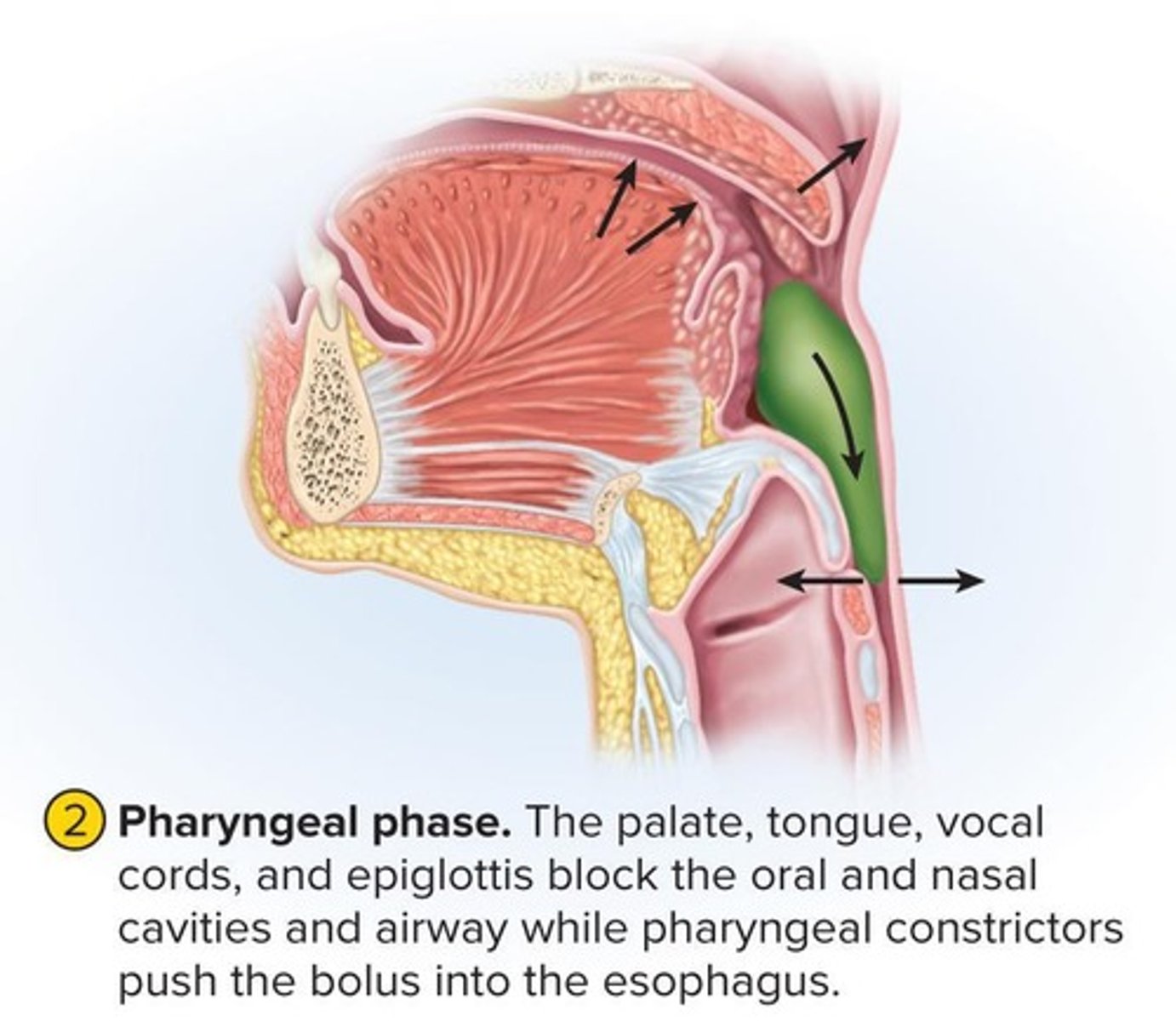
What are the two layers of muscle in the pharynx?
A deep layer of longitudinal skeletal muscle and a superficial layer of circular skeletal muscles.
What is the function of the pharyngeal constrictors?
They force food downward during swallowing.
What happens to the inferior constrictor when not swallowing?
It remains contracted to exclude air from the esophagus.
What is the length of the esophagus?
25-30 cm long.
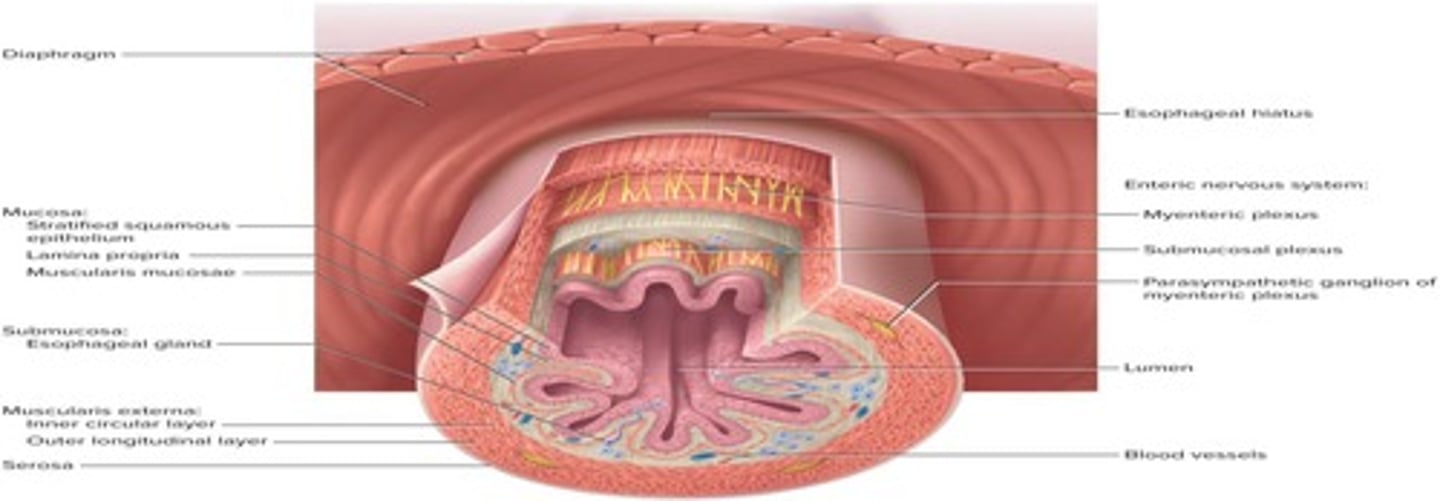
Where does the esophagus begin and end?
Begins at the level between C6 and the cricoid cartilage and extends to the cardial orifice of the stomach.
What type of epithelium lines the esophagus?
Nonkeratinized stratified squamous epithelium.
What are the pharyngeal sphincters?
Superior, middle, and inferior constrictor muscles that close and open, to push food down to the esophagus
What is the function of esophageal glands in the submucosa?
They secrete mucus.
What are the muscle types found in the esophagus?
Skeletal muscle in the upper one-third, a mix of muscle types in the middle one-third, and only smooth muscle in the bottom one-third.
What is swallowing (deglutition)?
A complex action involving over 22 muscles in the mouth, pharynx, and esophagus.
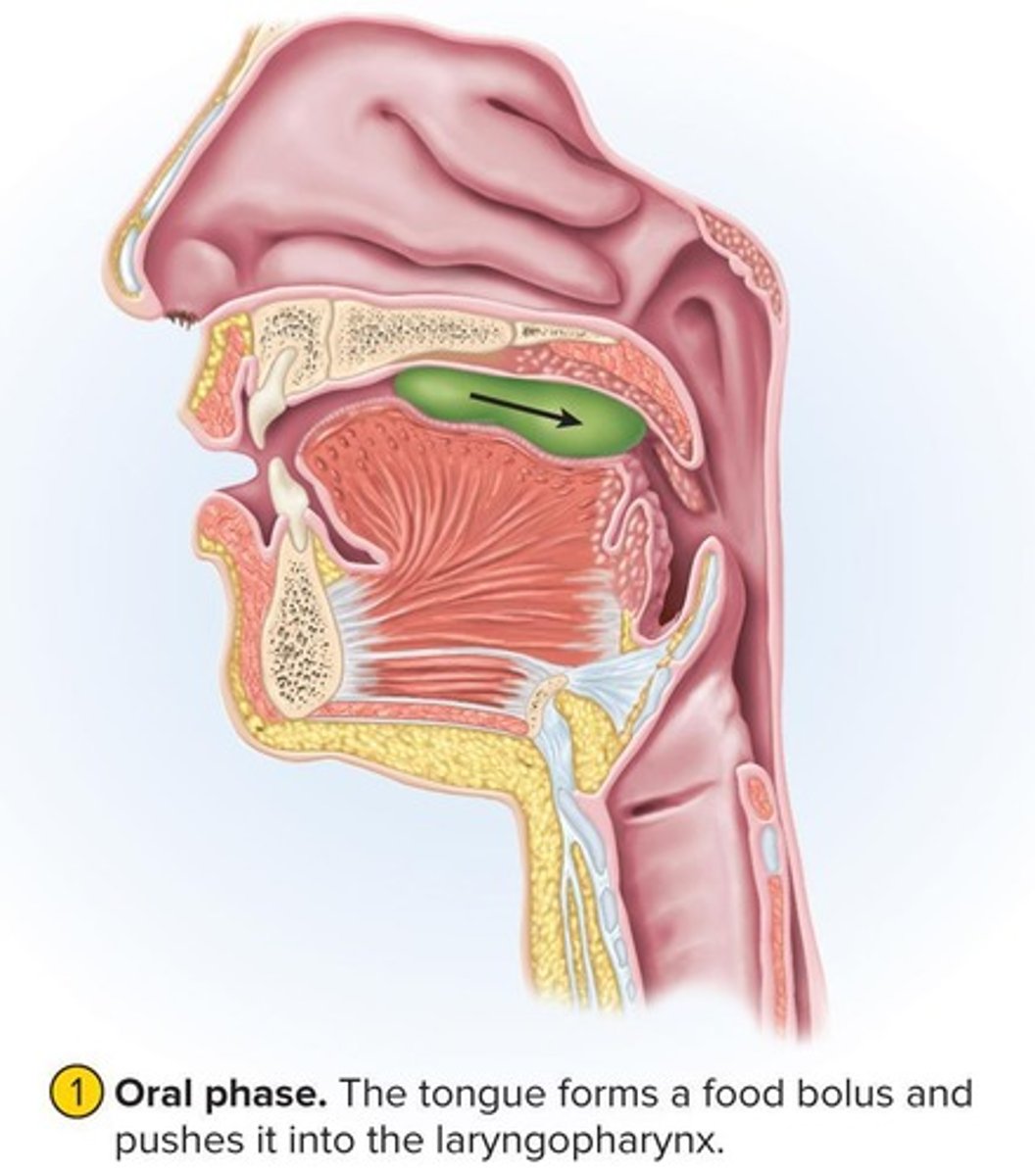
What is the role of the swallowing center?
A pair of nuclei in the medulla oblongata that coordinates swallowing.
What are the three phases of swallowing?
Oral phase (voluntary), pharyngeal phase (involuntary), and esophageal phase (involuntary peristalsis).